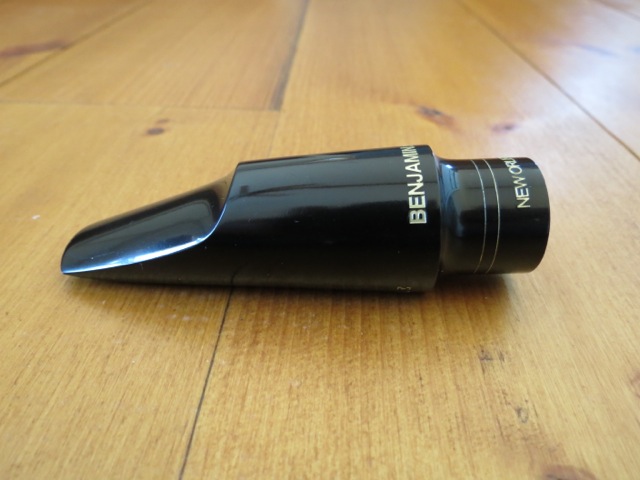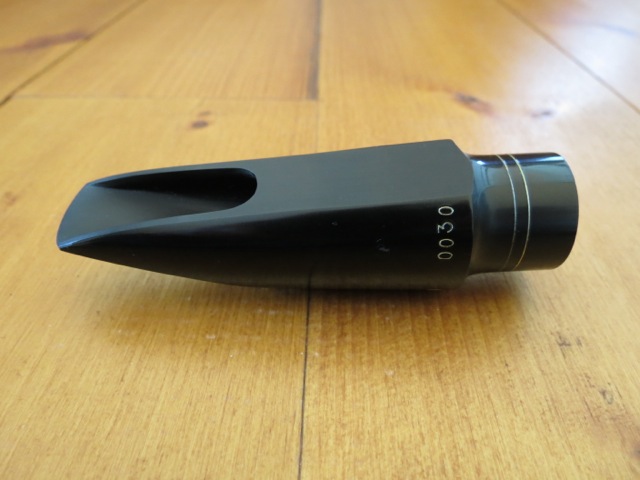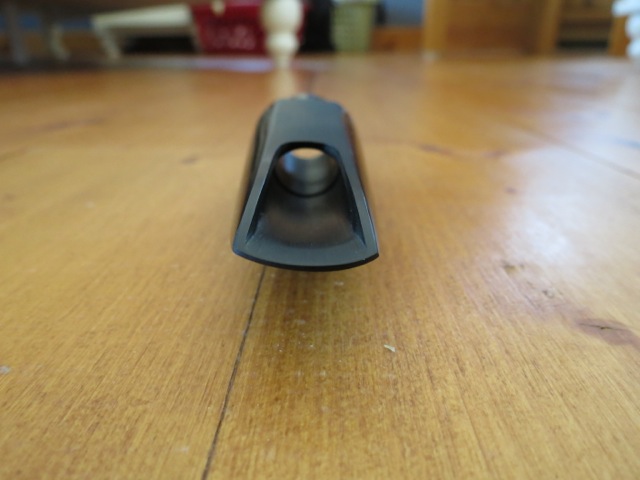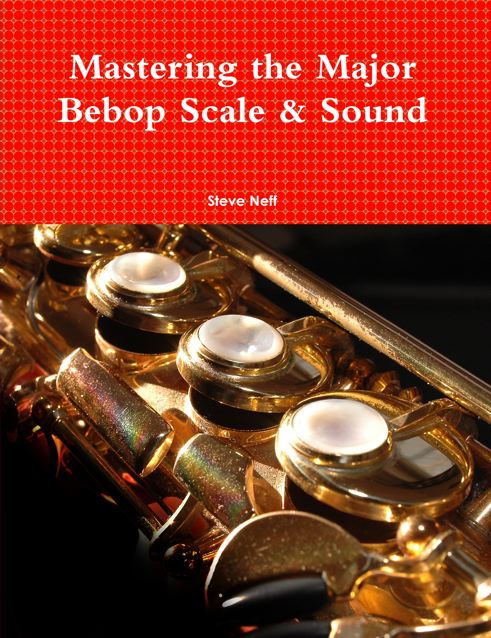Today, I am reviewing another hard rubber tenor saxophone mouthpiece from Benjamin Allen. It is another 10E model but this one is at a huge .135 tip opening. I have to admit that I have never played a .135 tip opening before. I usually start complaining that a tip opening is too wide when I hit around .115 or so, so this is new territory for me………..
Benjamin Allen mentored under “Doc” Tenney and after Doc’s death decided to carry on his tradition and dedication to the mouthpiece making craft. Ben decided to come out with a 10E model in honor and memory of Paul “Doc” Tenney” himself as a reflection of Doc’s work and mentorship. Here are a few words from Ben’s site on the 10E:
“I have placed every ounce of my knowledge, skill, and training into making this mouthpiece worthy of carrying the mighty initials “10E”– I do not and will not ever take this obligation lightly. While my model “10E” is an exceptional mouthpiece reminiscent of Doc’s Jazzmaster, it is still not Doc’s work–it is my own. But I firmly believe this mouthpiece will fully reveal Doc’s outstanding mentoring and my dedication to the craft.”
Benjamin Allen 10E .135 Tenor Saxophone Mouthpiece
Here are some more bullet points from Ben’s website about the 10E model tenor saxophone mouthpiece he makes:
BULLET POINTS ABOUT THE MODEL 10E:
- This mouthpiece has a truly large chamber, yet it retains a nice level of relative focus and density to its spectral coloration and envelope.
- The walls are undercut, but there is a slight squeeze going into the chamber.
- The facing curve is moderately resistant on this mouthpiece.
- The beak design is based on a standard Otto Link.
- The ramp is undercut and the side rails are slightly thinned and balanced.
- The tip rail profile is significantly thinner that Dr. Tenney’s (this does not make it better; it’s different)
- My concept of “neutrality” is ever so slightly more brilliant than Dr. Tenney’s concept.
- Each mouthpiece is handmade and hand adjusted to ensure each piece approaches playing perfection.
- All steps are completed in the United States.
- Each mouthpiece is made of American hard rubber–sorry, but there is no plastic in my pieces.
Ben actually sent me three 10E mouthpieces to try and review. The 10E and the 10E+ models I have already reviewed. I thought it would be good to review this .135 also as many people ask me about what effects the tip size of a mouthpiece has on the sound and playability of a mouthpiece.
Benjamin Allen 10E .135 Tenor Saxophone Mouthpiece
When you open the package, there is nothing about this mouthpiece that says ” this is the greatest mouthpiece to ever exist and will change the future of saxophone sound forever” It isn’t shiny and doesn’t have glitter or anything. It’s pretty nondescript. It looks like your average black hard rubber mouthpiece with the words “Benjamin Allen” and “New Orleans” engraved on the top. When you turn the mouthpiece over and look at it in the light it looks perfect though. Not one ounce of asymmetry or imperfection. The table, rails and tip rail look even and perfect. The tip rail is thin and even as are the the side rails and baffle.
This 10E .135 tenor sax mouthpiece looks to have a higher rollover baffle than the regular .105 tipped 10E I reviewed. The baffle angles down into the large chamber. It almost seems like it goes straight to the back of the chamber but there is a slight scoop in the chamber at the bottom. The side rails are scooped out smooth and evenly. There is a slight protrusion around the back of the chamber where the chamber meets the bore as you look at the chamber from the tip.
Ben told me that this .135 tip has a longer facing curve on it of 52.5. I can tell it has a longer curve because where my embouchure sits on the mouthpiece is pretty close to the breaking point of a 48-50 length curve. If I go further on the mouthpiece the sound starts to get crass and out of control. On this .135 10E I could go further on the mouthpiece than usual. The sound just got a lot louder because more of the reed was vibrating but I didn’t lose any control which seemed to imply to me that the curve was longer.
Benjamin Allen 10E .135 Tenor Saxophone Mouthpiece
OK, on to reviewing the sound and playability of the 10E .135. I thought the 10E .135 would kill me honestly. I just imagined trying to play it and my head exploding trying to put enough air through that huge tip opening. The 10E .135 does take a different level of air and support to play with this big of a tip opening. I noticed that the level of air that I use on a .105 tip for loud volumes usually produces a 90% volume out of those mouthpieces. What I mean by that, is that I feel like I’m at the 90% level with that mouthpiece. I can push it a little more and get between 90-100% but not much more than that.
With the 10E .135, when I played with that same air, I felt like I was at a 60% volume. It sounded just as loud as my .105 90% loudness but it felt like there was another 40% of volume I could get if I really pushed it. That was the part I’m not used to! It get’s crazy loud volume but pushing it with that much more air is something I’m not used to and I found it would tire me out pretty quickly. The other thing I noticed is that when playing at softer levels the tone on my .105 would be rich and full but on the .135 it sounds like the tone has more air in it to me.
I believe these things can be overcome as you practice and get used to a wider tipped mouthpiece though. Matter a fact, after playing on the .135 all day I went back to the .105 tip and it felt like a pea shooter to me…………
The tone on the 10E .135 was full and big sounding but I found it more spread and hollow sounding than the .105 tip openings. Some of you might be confused by those terms so I’ll try to explain. By spread, I mean that the tone seems like a big wash or wave of sound. To me, it is like getting hit by a big wave at the ocean but with sound. A tone with a compact sound is more like getting hit by a water hose on the setting for a focused stream of water. The hollowness description I think is related because instead of hearing a compact core sound I hear that spread wash of sound. Usually, you can hear this difference more acutely when playing against a wall. When you play into a big open room most tones will sound spread because the sound is traveling and bouncing around the room before it hits your ears. When you turn and play into a wall, the sound comes out of your bell , hits the wall and bounces right to your ears. You get a more solid focused sound reflected back at you.
When I play a mouthpiece with a huge spread sound into a wall, it gets a little bit more focused but it still sounds like a big wash of sound to my ears. A mouthpiece with a tight core of sound will sound much more compact to me when played against the wall. That’s my experience anyways, of course this is all subjective so do with it what you will……….
The altissimo was easy to get on this mouthpiece although it felt slightly different to “voice”. It felt like my normal positions for the altissimo notes had to be exaggerated somewhat and I had to use more air to get the notes out easily. No big deal but just a slight difference in approaching and playing these notes on the .135.
I know for a fact that this mouthpiece can get a lot more volume than smaller tipped mouthpieces. I think that even playing with way more air I still was only hitting the 80% volume mark with this mouthpiece. I think if I spent even more time on it I could knock some walls over with it volume wise……….
Benjamin Allen 10E .135 Tenor Saxophone Mouthpiece
The Benjamin Allen 10E .135 Tenor Saxophone Mouthpiece was fun to play. After reviewing 3 of Ben’s mouthpieces now it is obvious that he knows what he is doing! Next, I have some Benjamin Allen “Tony Dagradi” models to review so stay tuned…………
If you like the sound of the clip below and the mouthpiece catches your interest then please contact Ben and give it a try. You can contact Benjamin Allen at his website at Allenmouthpieces.com. Tell him Steve sent you………….Great work Ben!!
Let me know what you think in the comments below. Thanks, Steve
Benjamin Allen 10E .135 Tenor Saxophone Mouthpiece







Great review. I like your sound on this big opening. You should not be afraid of experimenting a little more if you ask me…. 😉
Regarding describing a sax sound. I always imagine an equalizer. When you say spread, I would see an equalizer setting performing an U (with base an treble turned up). A focused sound would be more linear or maybe a little “upside down” U shape on the equalizer (lots of mid-tone). A bright sound would have the equalizer set with a lot of high frequencies setting (treble) and so on. Does it make sense?
Hi Jan,
Thanks for the comment. I never thought of the equalizer analogy but that is a good one. It would be interesting to play some of these mouthpiece into software that gives you a picture of the sound to see how it looks………..
Steve- I like the way you sound on this piece a lot! A little darker, a little airier but very beautiful.
Thanks Joel,
The bigger tip does get a massive sound and if I didn’t do all these mouthpiece trials I might spend a few months on the .135 and see what happens. With trying other smaller tipped mouthpiece it makes it really hard to switch back and forth though.
Awesome Steve, great sound dude…….and no reverb on this clip….go the dry real sound, can here the mouthpiece as it is, love it!!!
Steve,
I’ve listened to countless clips on your site and I have to say your sound on this ALLEN .135 is what I gravitate to more than all others. Sounds awesome! It reminds of the feeling and sound I thought I got from a similarly huge LAMBERSON J, so my question is what is it like outside the practice or recording room? I ask because, as big as it felt alone, I couldn’t play it in mixed company…I felt lost.